Survey results report
Bewdley Housing Needs 2023
Last updated: April 2023
Lead officer: Ann-Marie Bishop, Housing Services Officer.
Contents
- Introduction
- Background
- Housing information
- Location and geographic extent of survey
- Methodology
- Responses
- Housing Needs Summary
- Results from the questionnaire
- Section 1: Current Accommodation
- Section 2: Affordable Housing
- Section 3: Alternative Accommodation
- Section 4: Additional Households
- Section 5: People looking to move back in to Bewdley
- Section 6. Summary of homes required in the town
- Section 7: House Price, Availability and Analysis
- Section 8: Community Led Housing Scheme and Self-Build
- Section 9. Conclusion
- References
- Appendix One
- Appendix Two
- Appendix Three
1.1 Housing needs surveys are undertaken to identify the local housing needs of a parish and the type and mix of housing that may be appropriate to meet these needs.
1.2 A housing needs survey was carried out during March and April 2023 in Bewdley Town Parish to establish what the expected housing requirements would be and to gain residents’ views for the town in the next 5-10 years.
1.3 Letters were circulated to all households in the town inviting the residents or those with a local connection to the town to complete an online survey. The information gathered from the responses has been used in this report to complete our analysis for this report
1.4 Housing Need surveys are therefore a useful ‘snapshot’ of the local situation at a given point in time and can complement the existing housing need information held by the Council. The survey will be a useful tool for town councils in assessing their housing needs and priorities and in informing the proposed Neighbourhood Plan.
2. Background
2.1 The 2021 Census advised that Bewdley Town had a population of 9,300, (51.2%) females and 48.8% males (ONS Census 21 figures)
2.2 Table 1 below shows Bewdley’s population broken down and shown as a percentage as well as a comparison against local and national trends.
Table 1
|
Age Groups |
Bewdley (%) |
Wyre Forest (%) |
England (%) |
|---|---|---|---|
|
15 & under |
12 |
15 |
17 |
|
16-64 |
56 |
60 |
65 |
|
65+ |
32 |
25 |
18 |
2.3 Bewdley has a slightly lower proportion of all age groups under 64 in comparison to the district and a higher population of 65+ year olds in comparison to the district and national figures.
2.4 Table 2 below shows the comparison of the economic activity across the town against local and national trends.
Table 2
|
Economic Activity |
Bewdley (%) |
Wyre Forest (%) |
England (%) |
|---|---|---|---|
|
Economically Active in employment |
49 |
54 |
57 |
|
Economically active unemployed |
2.5 |
2.9 |
3.5 |
|
Economically inactive |
48.5 |
43 |
39 |
2.5 Bewdley has a lower percentage of residents in employment than the district and nationally and almost equally has a higher percentage that is economically inactive compared to the district and nationally.
2.6 Table 3 below shows the comparison of the type of dwellings in the town in comparison with the whole of Wyre Forest and the England average.
Table 3
|
Proportion of dwellings by type |
Bewdley (%) |
Wyre Forest (%) |
England (%) |
|---|---|---|---|
|
House or Bungalow |
85 |
85 |
77 |
|
Flat, maisonette or apartment |
10 |
13 |
22 |
|
Caravan |
5 |
2 |
0.4 |
2.7 Bewdley has a large proportion of houses and bungalows in comparison to national and a significantly lower number of flats, maisonettes and apartments compared to nationally.
2.8 Table 4 below shows the tenure types and a comparison.
Table 4
|
Proportion of households by tenure |
Bewdley (%) |
Wyre Forest (%) |
England (%) |
|---|---|---|---|
|
Owned Outright |
50 |
41 |
33 |
|
Owned with a mortgage or loan |
26 |
29 |
29 |
|
Social Rented |
9 |
14 |
17 |
|
Private Rented |
15 |
16 |
21 |
Figures for tables 1-4 provided by the 2021 census, ONS Crown Copyright
2.9 The amount of people owning outright in Bewdley is higher than the district and national figures. The town also has a lower percentage of residents who are renting privately or socially compared to the Wyre Forest and national percentages.
3. Housing information
3.1 The number of people on housing registers for affordable homes in England has soared, in 2022 there were 1,206,376 households on social housing registers in England. This is an increase of 5% since 2020 when there were 1,145,132 households on social housing registers. (Shelter) Waiting lists have grown substantially over the last 5 years and there are currently just under 4000 on Wyre Forests housing register for social housing compared to data from 2019/20 showing just over 2000.
4. Location and geographic extent of survey
4.1 Bewdley sits just outside Kidderminster Town on the edge of Wyre Forest District, with a current population of 9,300 (ONS census 2021) it is a historic Georgian town and has five primary schools and one high school. Bewdley is defined as a Market Town within the settlement hierarchy of Wyre Forest District and has a commercial area adjacent to the River Severn and other local facilities and services.
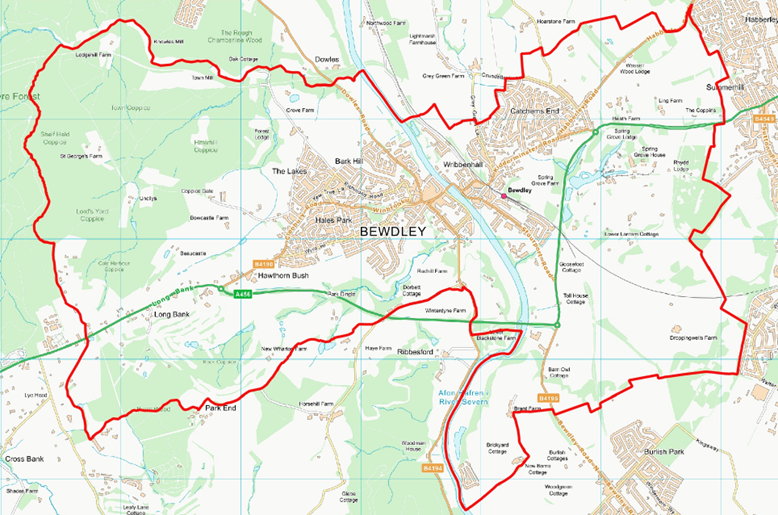
A Map of Bewdley.
5. Methodology
5.1 Wyre Forest District Council conducted the survey to establish the housing requirements for Bewdley over the next 10 years. This information will help to inform the Neighbourhood Plan, the survey ran for 6 weeks commencing on the 1st of March and ended on 12th April 2023. All households in Bewdley Town parish received a letter inviting them to complete the questionnaire online, or to contact Wyre Forest District Council directly to complete the survey over the phone, households were also invited to attend any one of the 4 drop-in session that had been arranged in Bewdley where they could get further information regarding the survey and complete the questionnaire. Altogether 4850 letters were posted and officers of Wyre Forest District Council worked in partnership with the town council to encourage residents to take part in the survey.
5.2 A reminder letter was also sent to all households on the week commencing 20th March encouraging them to respond to the survey and explaining the importance of their opinion.
5.3 A further 196 letters were sent to applicants on Wyre Forest District Council’s housing waiting list, Home Choice Plus, who had indicated a preference to live in Bewdley and had a local connection to the town.
5.4 The aim of the survey is to establish:
- The mix of housing need in the town
- The type of connection the household had with the town
- The maximum price range the household could afford, if looking to buy a property
- The maximum monthly rent the household could afford, if looking to move from existing property
- The tenure type (open market, subsidized, social rented or shared ownership)
- The size of the property and need by population (families, single people or older households)
5.5 The survey also gathered information from households that are likely to be subject to change in the next 5 -10 years, for example children looking to move out of the current family home but stay within the town, this was open to anyone who had moved out of the town and was looking to move back into the area.
6. Responses
6.1 A total of 4850 letters were distributed and 1002 responses were received, giving a return rate of 20.6%. It should be noted that generally only those people who have a housing need or are interested in a local needs development and town life are likely to respond.
Of the 1002 responses received, the majority of people currently live in the parish (94%). The average length of time that respondents have lived in the parish is 27 years.
7. Housing Needs Summary
7.1 The results of the housing needs survey are detailed further on in this report however in summary:
7.2 There were 418 households looking to move, find alternative housing or need additional homes within the next 10 years. Some households were looking for more than one additional home. Of those that responded, 125 could have their housing need met by natural churn and an additional 42 could have their housing need met by what is currently available on the open market equalling 167 in total. This is obviously subject to the property being suitable, becoming available at the right time and being affordable for the household in question.
7.3 Of the 418 who are looking to move and considering the 167 whose needs could be met by the open market and natural churn, the results indicate that a total of 251 new homes would be needed to meet their requirements.
7.4 Of the 251 households that responded confirming they have or will have a housing need within the next 10 years, the majority have advised that they will require a 2-bedroom property followed by a 3-bedroom property with the highest need being a house closely followed by a bungalow.
7.5 At the time of writing this report, 98 properties were for sale in Bewdley and five for rent, 42 of these met the property size, type and cost bracket as indicated by the of respondents in the survey.
7.6 Therefore, it can be shown that in the next 10 years, 251 homes will be required in Bewdley of which 55% of households advised that they would want a 2-bedroom property and 23% would want a 3-bedroom property, 33% of the respondents of survey advised they wanted a house followed by 32% wanting a bungalow. The highest need regarding tenure type is 54% wanting owner occupier followed by unknown 17% and social rented 10%. This shows there is an indicative need for low-cost home ownership products.
8.Results from the questionnaire
Section 1: Current Accommodation
This section of the survey asked householders about their current accommodation and if they have/are working in the town. It also asked if they have family in the town and any other strong local connections.
Q1. Do you currently live…?
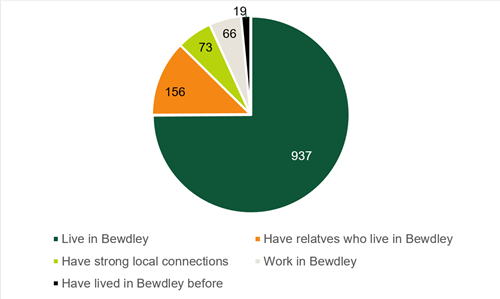
Figure 1 Do you currently..?
1.1 In total 999 respondents answered this question and three did not answer. It should be noted that respondents can give multiple answers to this question, 94% (937) selected that they live in the town, 16% (156) have relatives living in Bewdley, 7% (73) having a strong local connection to the town, 6.5% (66) work in Bewdley, and 2% (19) indicated they had lived in Bewdley before.
1.2 The average length of time respondents have lived in Bewdley is 27 years, answers ranging from as little as one year or less increasing to as many as 90 years.
1.3 Of the 66 respondents who indicated that they work in Bewdley, the average length of time working was 25 years, ranging from three years to 58 years.
1.4 Of the 156 who advised that they have relatives in Bewdley, the average length of time was 41 years, ranging from seven years to 100 years.
1.5 A total of 19 respondents answered that they had previously lived in Bewdley and 12 of these 19 were looking to return. An additional four were also looking at returning that had a strong local connection for example had grown up in Bewdley or returning for family reasons. The average time households had previously lived in Bewdley was 14 years.
1.6 We received 73 respondents who indicated a strong local connection, with various reasons given including previously working in Bewdley and are now retired, or members of the town council and other organisations or had children in the local schools.
Q2. Including yourself, how many people are there in your household?

Figure 2 - Including yourself, how many people are there in your household?
2.1 Out of the 924 people who responded to this question, the household make up identified 1678 adults and 228 children, giving a simple average of 2 adults and 1 child per household of the 924 adults, 790 stated they do not have any children living at home.
Q3. What type of property do you currently live in?
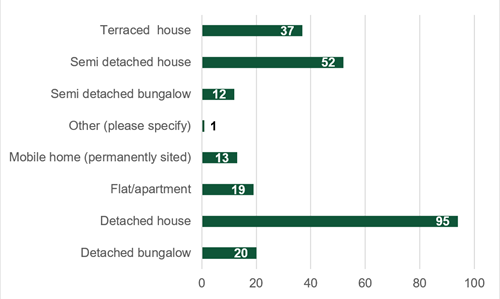
Figure 3 - What type of property do you currently live in?
3.1 Of the 249 who responded to this question most households currently live in a detached house 38% (95) followed by a semi-detached house 21% (52). The respondent who answered with ‘other’ specified a terraced bungalow. This shows the data collected by the Census in table 3 page 4 to corroborate with the findings in this question, there is a significantly higher number of residents living in a house and/or bungalow compared to flats/apartments and motorhomes.
Q4. How many bedrooms does your home have?
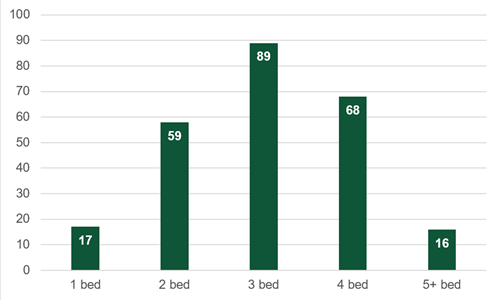
Figure 4 – How many bedrooms does your home have?
4.1 There were 249 respondents who answered this question, analysis of the answers shows that 36% (89) have three bedrooms and 27% (68) have four-bedroom properties, these were amongst the most common property types with five bedrooms 6% (16) and one bedroom 7% (17) being the least common.
4.2 Census data shows us that 41% of homes in Bewdley are 3-bedroom properties, thus supporting the results collected above. The Census data also shows us that 30% are 2-bedroom properties and 21% are 4-bedroom properties. The data above shows that there was a higher percentage of people entering the survey in 4-bedroom properties than 3-bedroom properties.
Q5. Is your home…?
5.1 This question looked at the tenure of the respondent’s current property. In total 217 households answered the question with the majority being owner occupier either owned outright 54% (118) or with a mortgage 22% (47). Closely followed by private rent 17% (37). The census data in table 4 page 4 shows this percentage is expected with owner occupiers and the higher number in private rented properties compared to social rented properties.
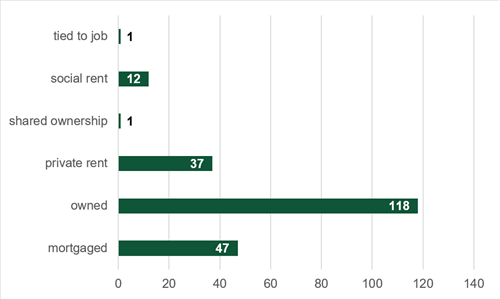
Figure 5 - Tenure of property
Q6. Has anyone from your family moved away from Bewdley in the last 5 years?
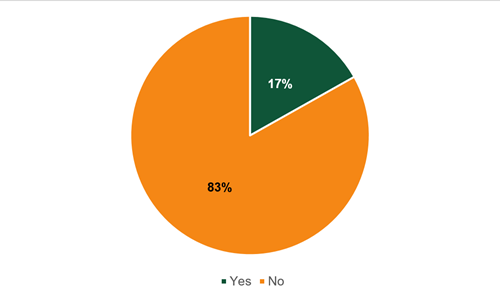
Figure 6 - Has anyone from your family moved away from Bewdley in the last 5 years?
6.1 Out of the 926 who answered this question, 83% (770) stated ‘No’ a family member had not previously moved out of Bewdley and 17% (156) said ‘Yes’ family members have moved out of their house, the graph (Q7) below shows the breakdown of reasons why.
Q7. Details of their reason for leaving
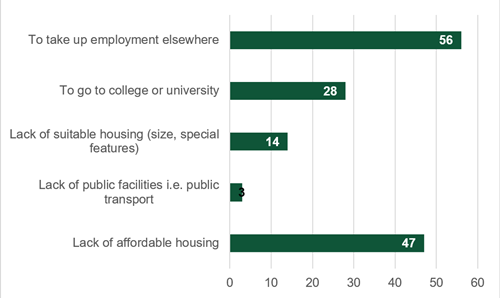
Figure 7 -Details of household members' reasons for leaving
7.1 Out of the 156 respondents stating ‘Yes’ a family member had moved out of Bewdley, 149 specified reasons such as taking up employment elsewhere (36%), and lack of affordable housing (30%). With the next biggest reason to continue education (18%).
Section 2: Affordable Housing
This section asked the respondents to give us their views whether they believed there was adequate affordable housing and facilities within the parish.
Q8. Do you feel that the town has a suitable range of housing for the current community and the people who would like to live there?
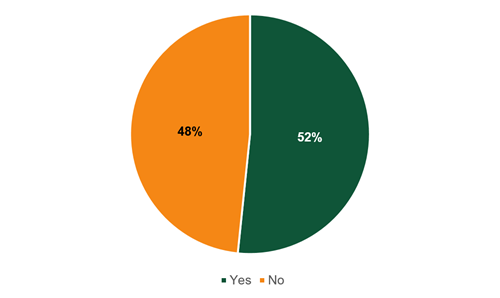
Figure 8 - Do you feel that the town has a suitable range of housing for the current community and the people who would like to live there?
8.1 We received 887 respond to this question with 52% (458) agreeing there is a suitable range of housing for the current community and 48% (429) specifying ‘No’ there is not a suitable range of housing.
8.2 The most common answers expressed were that there is not enough affordable housing, there is a lack of starter homes and smaller properties for first time buyers and not enough bungalows or ground floor accommodation for people looking to downsize. Below are some comments that we received.
‘There needs to be more affordable housing. The housing stock needs to be environmentally friendly/energy efficient.’
‘Perfectly adequate for the current community’
‘Not enough affordable homes for young people starting out.’
‘Bewdley is a small country town, and residents do not want it to grow so much that they lose that’
‘There is a distinct lack of affordable bungalows and other suitable properties for older people wishing to downsize.’
‘Seems to be quite a good range of properties’
‘Most properties are too expensive for young first-time buyers which results in them leaving the area creating an aging population.’
‘Limited availability of suitable housing for the older demographic, who wish to downsize. This has a knock-on effect on the availability of more affordable homes for young people who want to remain in the town where they grew up.’
Q9. Do you feel that the town has adequate facilities e.g., public transport for the current community and the people who would like to live there?
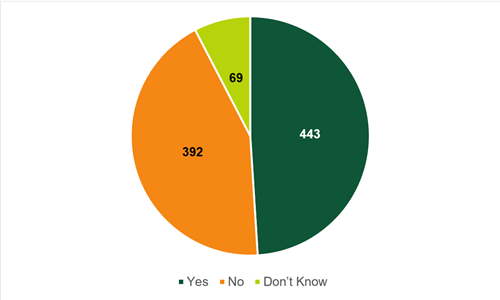
Figure 9 - Do you feel that the town has adequate facilities e.g., public transport for the current community and the people who would like to live there?
9.1 We received 904 responses regarding the current facilities in the parish, 49% felt there were already adequate facilities and 43% felt there was not. 8% were unsure.
9.2 We asked respondents to expand on the reasons for their answers. The most common answer was that Bewdley needed better public transport links and increased infrastructure to cope with the demand on the town. Respondents also commented that the healthcare facilities were oversubscribed and more car parking at a cheaper rate was needed. It was also noted that residents wanted to see more variety of shops and have a leisure facility.
9.3 Below are some comments that we received.
‘Infrastructure appears to be at a limit and any additional housing will need to contribute to this – particularly schools and medical facilities.’
‘Nice cross section of shops and activities’
‘…the bus services are already inadequate and unlikely to improve.’
‘Needs a swimming pool and affordable recreational facilities for children and teenagers.’
‘All facilities are available in the town’
‘I feel that we need more schools, medical centres and better transport system.’
‘We need a greater range of shops and services.’
Q10. To what degree would you support a development of new affordable housing for rent/shared ownership within your town for people with a local connection?
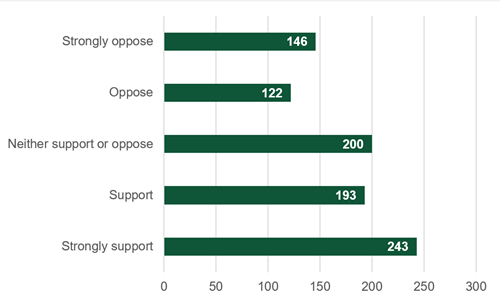
Figure 10 - To what degree would you support a development of new affordable housing for rent/shared ownership within your town for people with a local connection?
10.1 We received 904 responses to this question with 16% (146) strongly opposing the development of new affordable housing in the parish and 27% (243) strongly supporting. If combining the results of oppose and support with strongly oppose and strongly support, we find that 30% strongly oppose/oppose and 48% strongly support/support with 22% (200) neither support nor oppose.
10.2 There were 547 comments received, here are some examples below.
‘There is a need for social housing.’
‘We need to look after our community, providing them with affordable homes is a way of doing this.’
‘Bewdley is a small Georgian Town. I would very much like to keep it this way.’
‘Infrastructure isn’t adequate, and I think current houses will lose value because of the demographic shift. People live in Bewdley because it is aesthetically pleasing and still rural. We need to stop urbanising it!’
‘I want my 8 grandchildren to be able to stay in this lovely location if they want to. They will need low-cost starter homes in order to help them do this, thereby contributing to a future healthy, thriving local community.’
‘The level of any development needs to be carefully considered given the lack of potential sites for such change.’
Q11. Are any of your household registered with Wyre Forest District Council on the home Choice Plus Housing Register for either social housing or shared ownership housing?
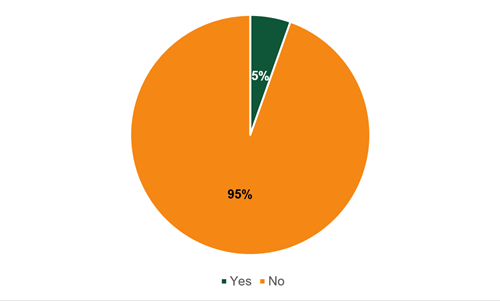
Figure 11 - Are any of your household registered with Wyre Forest District Council on the home Choice Plus Housing Register for either social housing or shared ownership housing?
11.1 We received 902 responses to this question with 95% (853) stating no and 5% (49) stating yes.
Section 3: Alternative Accommodation
This section of the survey asked the householders if they were likely to move home now or within the next 10 years, if they indicated that they would be looking for alternative accommodation, then they were asked further questions about the type of property they would prefer to move into, the tenure type and the affordability. The responses to these questions are used to inform future housing needs in Bewdley.
Q12. Are you, the householder, looking to move into alternative accommodation within the town in the next 10 years?
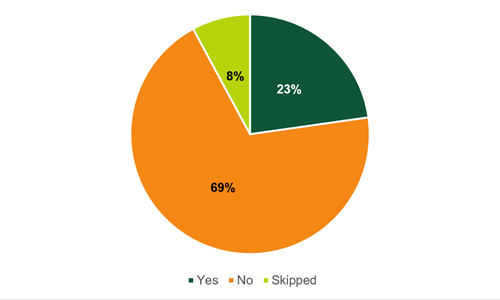
Figure 12 – Are you, the householder, looking to move into alternative accommodation within the town I the next 10 years?
12.1 Out of the 1002 respondents 69% (695) answered ‘No’ they were not looking for alternative accommodation within the town in the next 10 years and 23% (228) answered ‘Yes’.
12.2 The tables in appendix one shows the respondents current living arrangements and the size and tenure of the alternative accommodation they will need in the next 12 months, the next 13 months to 5 years and 5 to 10 years.
Q13 When would you, the householder, expect to move? If looking for alternative accommodation
13.1 In total 228 respondents indicated they would require a home in Bewdley within the next 10 years.
13.2 26% of households who responded advised they would be looking to move within the next 12 months, 45% will be looking to move in the next 13 months to five years and 29% within the next five to 10 years.
Q14 What type of accommodation would you prefer?
14.1 Of that 228, respondents indicated the type of accommodation they would prefer with the majority looking for a house (39%) or a bungalow (39%).
Q15 How many bedrooms would you require?
15.1 The highest bedroom need was two at (38%) or three (36%) bedroom properties, with the next highest demand of four bedrooms (9%).
Q16. Why does your household need to move?
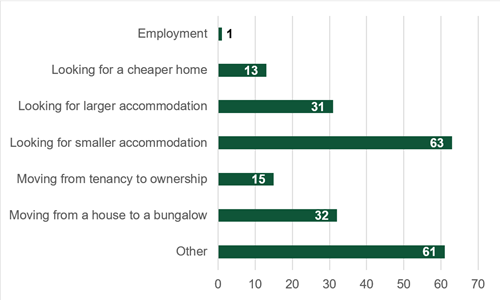
Figure 16 - Why does your household need to move?
16.1 Out of the 228 respondents, it was clear to see that 28% (63) were looking for smaller accommodation and 14% (32) were looking to move from a house to a bungalow. With ‘others’ 27% indicating reasons such as ‘some sort of sheltered accommodation, health reasons, closer to relatives, somewhere to retire.’
Q17. Would you expect to be…?
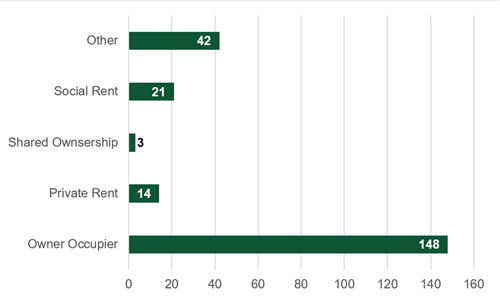
Figure 17 – Would you expect to be…?
17.1 Out of the 228 respondents, most expect to be owner occupiers (65%), 9% indicating they would like to rent from a housing association, 1% wanted a shared ownership property from the housing association, 6% would like to privately rent and 18% selecting ‘other’ and specifying ‘retirement village like Berrington Court or supported living’.
17.2 When questioned on how much the householder would be able to afford if renting an alternative property, 90 respondents answered this question indicating 17% could afford between £601 to £700 per calendar month and 33% indicated they could afford from £700 to over £900 per calendar month. Current rental values in the area are in the range of £650 per calendar month upwards for a 2-bedroom property. (Rightmove April 2023) The average price range for renting in Bewdley is £934 per calendar month, based on this average only 12% would be able to afford this price range, indicating a need for lower cost homes for alternative accommodation. (home.uk)
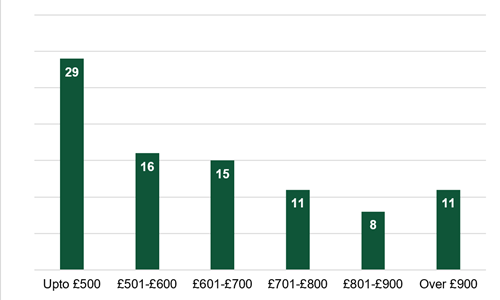
Figure 17.2 – How much would you be able to afford if renting?
17.3 When questioned on how much the householder would be able to afford if purchasing an alternative property, 186 respondents answered this question 13% indicating they could afford between £200,001 to £250,000, 23% indicated that they could afford between £250,000 to £300,000. The average sale price in Bewdley was £320,686 (Rightmove April 2023). Based on the responses received this would indicate that only 47% could afford the average sale price and shows there is demand for more low-cost home ownership options is needed for alternative accommodation.
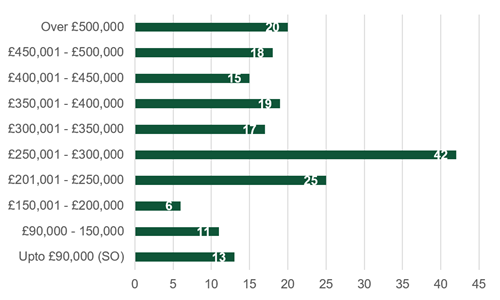
Figure 17.3 – How much would you be able to afford if purchasing?
17.4 Out of 228 respondents who answered the question regarding alternative accommodation, 8% (18) did not answer any question regarding renting or buying.
Section 4: Additional Households
This section asked the respondents if any current members of their household would be looking to move within the next 10 years to create a new separate household within the town. If they indicated that there would be members looking to create a new household, then we asked them for more information including the property type that they would prefer to move into, the tenure type and the affordability.
Q18. Is anyone looking to move out of your home into a new household within the town in the next 10 years?
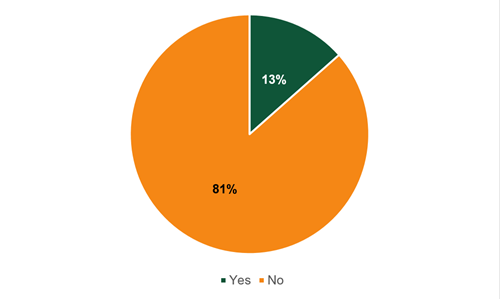
Figure 18. Is anyone looking to move out of your home into a new household within the town in the next 10 years?
18.1 A total of 13% (126) respondents indicated that members of their current household will be looking for an additional home(s) within the next 10 years, 81% (809) indicated ‘No’. 7% did not answer this question.
18.2 How many current household members wish to form a new household inside the town within the next 10 years?
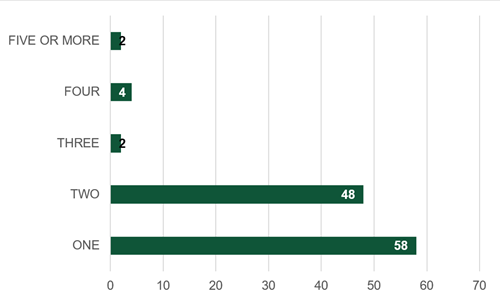
Figure 18.2 - How many current household members wish to form a new household inside the town within the next 10 years?
18.3 Of the 126 respondents the majority needed one additional home 46% (58), followed by 38% (48) requiring two additional homes.10% of respondents did not answer how many they needed. This question gave the respondent four opportunities to indicate the number of additional households required allowing the survey to take into account multiple additional households from one original household. Therefore, of the 126 respondents who did answer, the survey shows that 167 additional homes are required.
Q19. When would the new householder, expect to move?
19.1 Of the 126 respondents that said yes, 167 family members indicated they would require a home in Bewdley within the next 10 years.
19.2 16% of households who responded advised they would be looking to move within the next 12 months, 43% will be looking to move in the next 13 months to five years and 41% within the next five to 10 years.
Q20. What type of accommodation would you prefer?
20.1 Of that 167, respondents indicated the type of accommodation they would prefer with the majority looking for a house 49% or a flat 32%.
Q21. How many bedrooms would you require?
21.1 The highest bedroom need was two at (58%) or three (22%) bedroom properties, with the next highest demand of one bedroom (16%).
Q22. Why will the new household be created?
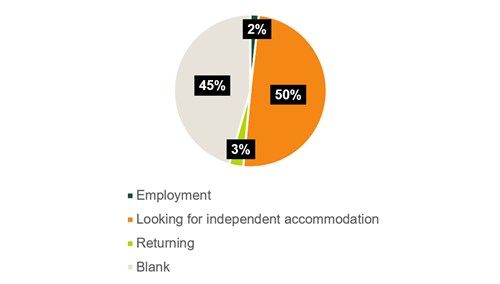
Figure 22 – Why will the new household be created?
22.1 Out of the 167 answered it was clear that 50% (83) were looking for independent accommodation and 45% (76) did not answer this question.
Q23. What tenure type would be preferred for the new household…?
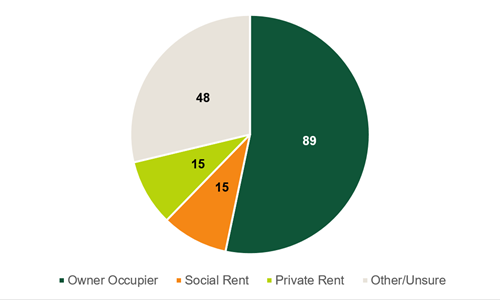
Figure 23 – What kind of tenure would be preferred for the new household…?
23.1 Out of the 167 answers most expect to be owner occupiers 53%, whilst 9% indicated they would want to rent from a housing association and 9% would prefer to rent privately. ‘Other’ was selected by 29% specifying ‘not sure’ or ‘it depends on what they could afford’.
23.2 When questioned on how much the new householder would be able to afford if renting an additional property 35% indicated they could afford between £501 to £600 per calendar month and 33% indicated they could afford up to £500 per calendar month. Of the 167 answers 3 indicated that they could afford between £801-£900 per calendar month (4%) and 3 advised they could afford over £900 per calendar month. Based on the average price of renting in Bewdley (£934pcm as of April 2023), only a possible 4% could afford to rent on the current open market when looking for additional properties.
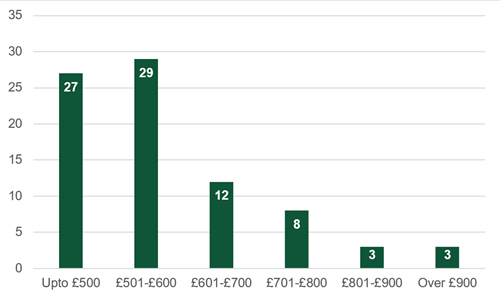
Figure 23.2 – How much would you be able to afford if renting?
23.3 When questioned on how much the new householder would be able to afford if purchasing an additional property, 31% indicated they could afford £90,000 to £150,000. With the next highest being 20% indicating that they could afford from £201,000 to over £250,000.
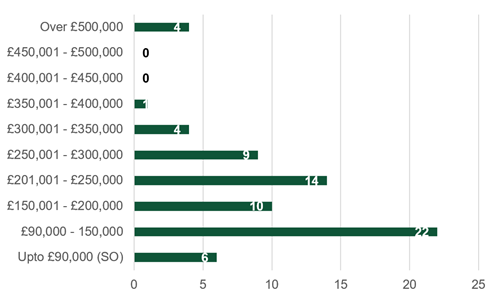
Figure 23.3 – How much would you be able to afford if purchasing?
*SO = Shared ownership
23.4 Research shows properties in Bewdley had an average sale price of £320,686 (Rightmove April 2023). The majority of properties sold were semi-detached properties with an average price of £322,572. Terraced properties sold for an average of £251,870, and the average price for a detached property selling for £512,190. (Rightmove April 2023) From the answers given a possible 13% could afford the average sale price indicating that the demand for more low-cost home ownership options is needed for additional accommodation.
Section 5: People looking to move back in to Bewdley
This section asked the respondents if they had a local connection such as work, relatives or had previously lived in Bewdley and were looking to live in Bewdley and what was their preferred property type, bedroom need and tenure.
Q24. Are you looking at moving in to Bewdley in the next 10 years?
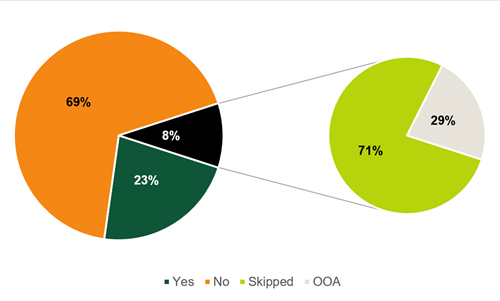
Figure 24 – Are you looking at moving in to Bewdley in the next 10 years?
*OOA = Out of area.
24.1 We received 23 respondents who indicated they would like to return to Bewdley. The tables below detail what time period and also what their preferred property, bed capacity and tenure would be.
24.2 Additional homes needed in the next 12 months for people returning to Bewdley.
|
Preferred Property Type |
Preferred Property Size |
Preferred Tenure Type |
|---|---|---|
|
Detached bungalow |
2 beds |
Blank |
|
Detached bungalow |
2 beds |
owned |
|
Semi-detached house |
3 beds |
Blank |
|
Detached bungalow |
1 bed |
social rent |
|
Terraced house |
2 beds |
Blank |
|
Semi-detached house |
3 beds |
owned |
24.3 Additional properties needed in the next 13 months to 5 years for people returning to Bewdley.
|
Preferred Property Type |
Preferred Property Size |
Preferred Tenure Type |
|---|---|---|
|
Detached house |
4 beds |
Blank |
|
Detached house |
2 beds |
owned |
|
Detached bungalow |
4 beds |
Blank |
|
Semi-detached house |
3 beds |
mortgaged |
|
Semi-detached house |
2 beds |
Blank |
|
Mobile home (permanently sited) |
2 beds |
owned |
|
Blank |
Blank |
Blank |
|
Detached bungalow |
4 beds |
owned |
|
Mobile home (permanently sited) |
1 bed |
owned |
24.4 Additional properties needed in the next 5 to 10 years for people returning to Bewdley.
|
Preferred Property Type |
Preferred Property Size |
Preferred Tenure Type |
|---|---|---|
|
Detached house |
3 beds |
owned |
|
Terraced house |
2 beds |
owned |
|
Detached house |
4 beds |
mortgaged |
|
Detached bungalow |
2 beds |
owned |
|
Other (please specify) |
Supported living |
Supported living |
|
Flat/apartment |
2 beds |
owned |
|
Detached house |
3 beds |
mortgaged |
|
Semi-detached house |
3 beds |
mortgaged |
Q25. Are you looking to move in to Bewdley in the next 10 years?
25.1 23 respondents indicated they would require a home in Bewdley within the next 10 years.
25.2 26% of households who responded advised they would be looking to move within the next 12 months, 39% will be looking to move in the next 13 months to five years and 35% within the next five to 10 years.
Q26. What type of accommodation would you prefer?
26.1 Of that 23, respondents indicated the type of accommodation they would prefer with the majority looking for a house 52% or a bungalow 26%.
Q27. How many bedrooms would you require?
27.1 The highest bedroom requirement was for two at (39%) followed by three-bedroom properties (26%), with the next highest demand of four bedrooms (17%).
Q28. Why does your household need to move?
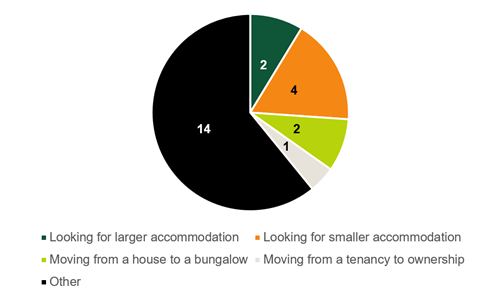
Figure 28 - Why does your household need to move?
28.1 Out of the 23 respondents who answered this question, 17% (4) were looking for smaller accommodation and 9% (2) were looking to move from a house to a bungalow, equally 9% (2) were looking for larger accommodation. With ‘others’ (61%) indicating reasons such as ‘school’ and ‘to be closer to my parents…’.
Q29. Would you expect to be…?
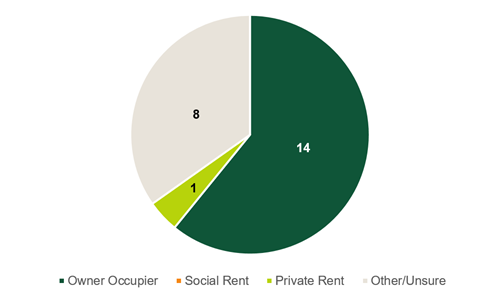
Figure 29 – Would you expect to be…?
29.1 Out of the 23 respondents who answered this question, most expect to be owner occupiers (61%), 4% expecting to be renting form a housing association, 0% expecting to private rent and 35% selecting ‘other’ and specifying ‘supported living’ or leaving it blank.
29.2 When questioned on how much the householder would be able to afford if renting accommodation in Bewdley, 50% indicated they could afford up to £500 a month, 38% could afford over £900. It should be noted that some respondents answered both renting and buying affordability questions and did not state the type of tenure they would be looking for. The current average property price for renting in Bewdley is £934 per calendar month, this means renting on the open market would only be accessible to the 38% that answered they could afford over £900 when moving back.
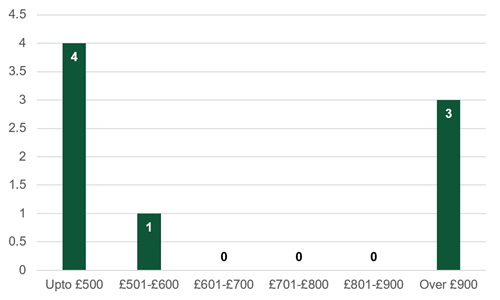
Figure 29.2 – How much would you be able to afford if renting?
29.3 When questioned on how much the householder would be able to afford if purchasing accommodation, 21% (4) indicated they could afford up to £90,000 with a close to equal split over the next pricing brackets. With the average sale price on the open market currently (April 2023) £320,686 in Bewdley, this would indicate only a possible 42% could afford properties on the open market for people returning to Bewdley i.e., those who indicated they could afford £300,001 and above.
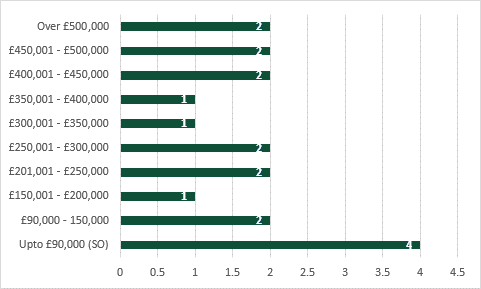
Figure 29.3 – How much would you be able to afford if purchasing?
*SO = Shared ownership
29.4 Out of 23 respondents, 17% (4) did not answer this question relating on whether they wanted to rent or purchase a property.
Section 6. Summary of homes required in the town
30.1 Further research into the responses received has shown that if we cross match the homes that in theory will be vacated to those that will be required for alternative, additional or people moving back to Bewdley with a local connection, the result will be the following housing need:
12 months
Figure 30.2 – Breakdown of housing need in the next 12 months
| Property Type | Total needed in next 12 months |
|---|---|
| Semi-detached bungalow | 4 |
| Detached bungalow | 16 |
| Terraced house | 2 |
| Semi-detached house | 23 |
| Detached house | 2 |
| Flat/apartment | 7 |
| Mobile home (permanently sited) | 0 |
| Other (please specify) | 4 |
| No Details | 2 |
| All | 60 |
30.2 Therefore, the demand in Bewdley for the next 12 months is 60 homes.
30.3 The largest need regarding the number of bedrooms required by a large proportion is 2 bedrooms with 48% of the demand, followed by 3 bedrooms with 30% with the lowest being four bedrooms 3% in the next 12 months.
30.4 The highest need regarding property types is houses with 45% followed by bungalow with 33% and flats/apartments with 12% in the next 12 months.
30.5 The highest need regarding tenure type is owner occupier with 45% followed by unknown 32%, social rent at 15%, other at 7%, shared ownership at 2% and private rent at 0% in the next 12 months. Respondents who selected other specified ‘not sure’ and ‘no private landlord.
13 months to 5 years
Figure 30.6 – Breakdown of housing need in 13 months to five years
| Property Type | Total needed in next 13 months to 5 years |
|---|---|
| Semi-detached bungalow | 16 |
| Detached bungalow | 20 |
| Terraced house | 8 |
| Semi-detached house | 21 |
| Detached house | 15 |
| Flat/apartment | 28 |
| Mobile home (permanently sited) | 5 |
| Other (please specify) | 9 |
| No Details | 4 |
| All | 126 |
30.6 Therefore, the demand in Bewdley in the next 13months to 5 years is 126 homes.
30.7 The largest need regarding the number of bedrooms required by a large proportion is 2 bedrooms with 56% of the demand, followed by 3 bedrooms with 22% with the lowest being four bedrooms 1% in the next 13 months to five years.
30.8 The highest need regarding property types is houses with 35% followed by bungalow with 29% and flats/apartments with 22% in the next 13 months to five years.
30.9 The highest need regarding tenure type is owner occupier with 56% followed by unknown 18%, social rent at 10%, private rent at 8%, shared ownership at 2% and other at 6% in the next 13 months to five years. Respondents who selected other specified ‘downsize from current house, no decision made yet’ and ‘near the town centre on the flat’.
5 – 10 years
Figure 30.10 – Breakdown of housing need in five to ten years
| Property Type | Total needed in next five to ten years |
|---|---|
| Semi-detached bungalow | 11 |
| Detached bungalow | 28 |
| Terraced house | 9 |
| Semi-detached house | 13 |
| Detached house | 4 |
| Flat/apartment | 33 |
| Mobile home (permanently sited) | 0 |
| Other (please specify) | 6 |
| No Details | 3 |
| All | 107 |
30.10 Therefore, the demand in Bewdley in the next 5 years to 10 years is 107 homes.
30.11 The largest need regarding the number of bedrooms required by a large proportion is 2 bedrooms with 59% of the demand, followed by 3 bedrooms with 19% with the lowest being four bedrooms 1% in the next five to 10 years.
30.12 The highest need regarding property types is bungalows with 39% followed by flats/apartments with 31% and houses with 24%.
30.13 The highest need regarding tenure type is owner occupier with 56% followed by unknown 21%, private rent at 11%, social rent at 6%, other at 5% in the next 13 months to five years. Respondents who selected other specified ‘retirement village like Berrington Court’ and ‘sheltered accommodation.
30.14 The table below shows a breakdown of dwellings required in the next 10 years.
Figure 30.15 – Breakdown of housing need in the next ten years
| Property Type | Total needed in next ten years |
|---|---|
| Semi-detached bungalow | 31 |
| Detached bungalow | 64 |
| Terraced house | 19 |
| Semi-detached house | 57 |
| Detached house | 21 |
| Flat/apartment | 68 |
| Mobile home (permanently sited) | 5 |
| Other (please specify) | 19 |
| No Details | 9 |
| All | 293 |
30.15 Therefore, the demand in Bewdley in the next 10 years is 293 homes.
30.16 The largest need regarding the number of bedrooms required by a large proportion is 2 bedrooms with 55% of the demand, followed by 3 bedrooms with 23% with the lowest being 5 bedrooms 1%.
30.17 The highest need regarding property types is houses with 33% followed by bungalow with 32% and flats/apartments with 23%.
30.18 The highest need regarding tenure type is owner occupier with 54% followed by unknown 17%, social rent at 10% and private rent at 8%.
Section 7: House Price, Availability and Analysis
This section breaks down what respondents are willing to pay and what properties are currently available within the town.
31.1 Respondents who have indicated that they have a housing need in the next 10 years were asked how much they felt they would be willing to pay if either renting or purchasing a property.
31.2 There were 180 responses who advised they would be looking to rent with the largest affordability range of up to £500 per calendar month (33%). The table shows a breakdown of affordability in renting and combines residents who are looking for alternative or additional accommodation and people with a local connection who want to return to Bewdley.
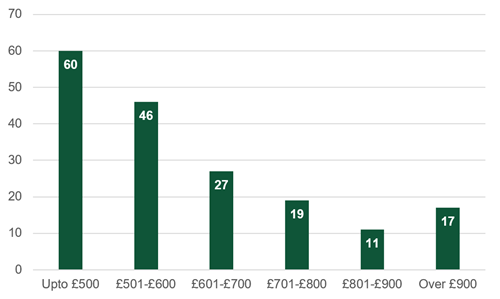
Figure 31.2 – Affordability range for renting in the next 10 years
31.3 In terms of purchasing a property, the highest response rate in the affordability category for alternative or additional accommodation and people with a local connection who want to return to Bewdley was £250,001 - £300,000 with 19% of the responses followed by £200,001 - £250,000 at 15%. The table below shows a breakdown of affordability for purchasing.
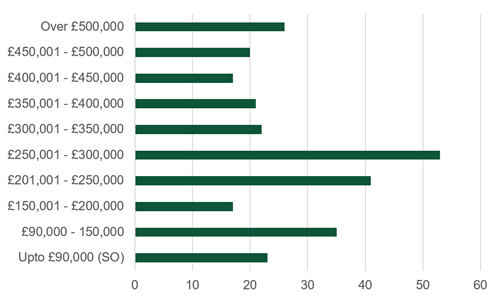
Figure 31.3 – Affordability range for purchasing a property in the next 10 years.
31.4 Research on Rightmove indicates that as of April 2023 there were 102 properties for sale in Bewdley and five properties to rent, 42 of the properties advertised for sale fall within the requirements specified in the responses received. Of the current advertised properties 18 would be suitable for respondents in the next 12 months, an additional 11 of these properties would be suitable in the next 13 months to 5 years and an additional 13 of these properties would be suitable in the next five to 10 years. There were also 4 possible matches of properties to respondent’s answers, unfortunately due to lack of information we are unable to guarantee them being an exact match. Out of the six properties currently for rent in Bewdley, we were able to match 3 respondents answers. (Figures from Rightmove)
31.5 This indicated there is some disparity between what people could afford to purchase in Bewdley and what is available, this is not uncommon and would indicate a need for a greater number of smaller homes and other affordable forms of housing.
31.6 The map shows the properties for sale in Bewdley April 2023.
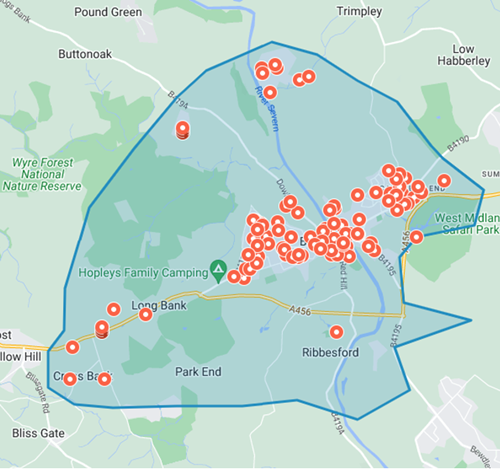
Figure 31.6 – Properties currently for sale on Rightmove in Bewdley.
31.7 Appendix three shows a breakdown of the properties for sale and asking price currently on Rightmove April 2023.
Section 8: Community Led Housing Scheme and Self-Build
This section addresses if respondents would be interested in taking a role in community led housing schemes or have an interest in a self-build project.
Q32. Would you be interested in taking a role in a community led housing scheme in Bewdley?
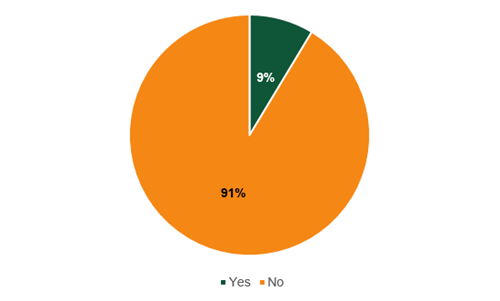
Figure 32 – Would you be interested in taking a role in a community led housing scheme in Bewdley.
32.1 891 respondents answered this question with the majority of 91% (814) advising No and 9% (77) answering Yes.
Q33. Would you be interested in a self-build project or having a custom build house in Bewdley?
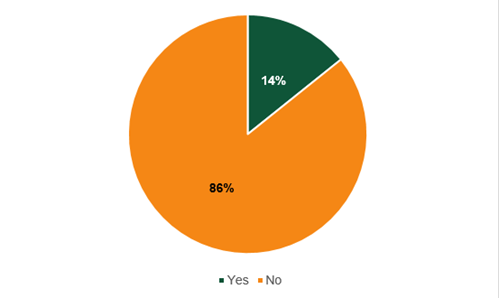
Figure 33 – Would you be interested in a self-build project or having a custom build house in Bewdley.
33.1 891 respondents answered with the majority 86% (764) not interested in a self-build project and 14% (127) who would be in favour of having a custom build house in the parish.
Section 9. Conclusion
34.1 Taking into consideration the breadth of the survey and the range of responses received, there is statistically significant sets of data generated to enable us to evaluate the information and draw conclusions. There was an overall response rate of 20.6% achieved.
34.2 Of the 418 responses received who indicated they wanted to move or required additional or alternative accommodation, the demand was as follows: - 228 would like alternative accommodation, 126 responses indicated that 167 additional properties would be required and 23 wanting to move back to Bewdley with a local connection, residents indicated they would be looking to move or need additional/alternative homes within the next 10 years.
34.3 The survey is also representative of a diverse cross section of the local community, including young people, single people, families and older households. Of note there is a higher response rate by households that include single and couples accommodating larger properties (3 bedroom plus) looking to move to bungalows or smaller accommodation 12% (68). This should be of note when identifying housing need for Bewdley.
34.4 Of the 418 responses who indicated they wanted to move, 125 could potentially have their accommodation needs met by natural churn. Those that required additional accommodation 42 could have their needs met from properties currently on the open market, equalling 167 in total. However, it must be noted that not all those whose housing needs can be met with natural churn will be able to afford the properties on the open market or that the properties available will be of a desired size, therefore it is evident that the need for new affordable housing will become greater especially for low-cost home ownership products. Therefore, the survey shows that a minimum of 251 additional homes will be required in Bewdley over the next 10 years.
34.5 The findings of the Housing Needs Survey support development opportunities that should arise. This survey clearly indicated that any development sites or new build accommodation they must include low-cost home ownership and affordable housing for rent of shared ownership (or other types of low-cost) homes.
34.6 Accommodation should be a mix of smaller sized properties and bungalows, 55% (162) advised that they would want a 2-bedrooms property and 23% (66) require a 3-bedroom property, 33% (97) of the respondents of the survey advised they wanted a house followed by 32% (94) indicated they wanted a bungalow. This shows that there is a need for housing growth beyond the current site allocations. The affordable housing should meet the requirements of the Council’s local connection in line with the allocations policy.
References
Rightmove www.rightmove.co.uk/property-for-sale/Bewdley.html accessed 13/04/2023
Census 2021 data www.ons.gov.uk/visualisations/customprofiles/build/ accessed 13/04/2023
Waiting list data – Shelter – www.england.shelter.org.uk/media/press_release/14000_social_homes_lost_last_year_as_over_a_million_households_sit_on_waiting_lists#:~:text=In%202022%20there%20were1%2C206%2C376,lettings%20and%20tenancies%2C%20Table%20600accessed 02/05/2023
Average rental prices – www.home.co.uk/for_rent/bewdley/current_rents?location=bewdley accessed 18/05/2023
Appendix 1
Appendix two
Details of properties for sale / rent
|
Property for sale/rent |
Price |
|---|---|
|
6 Bed Detached House |
£2,975,000 |
|
7 Bed Detached House |
£1,295,000 |
|
7 Bed Detached House |
£1,000,000 |
|
4 Bed Detached House |
£950,000 |
|
4 Bed Detached House |
£875,000 |
|
4 Bed Detached House |
£760,000 |
|
Detached House/ 6x 2 Bed Apartments |
£750,000 |
|
4 Bed Detached House |
£715,000 |
|
4 Bed Detached House |
£699,000 |
|
5 Bed Detached House |
£695,000 |
|
4 Bed Detached House |
£600,000 |
|
3 Bed Detached Bungalow |
£595,000 |
|
5 Bed Detached House |
£575,000 |
|
3 Bed Detached Bungalow |
£499,950 |
|
3 Bed Semi-Detached House |
£475,000 |
|
3 Bed Semi-Detached House |
£475,000 |
|
4 Bed Detached House |
£450,000 |
|
3 Bed Semi-Detached House |
£450,000 |
|
3 Bed Detached House |
£450,000 |
|
5 Bed Detached House |
£450,000 |
|
4 Bed Detached House |
£450,000 |
|
4 Bed Detached House |
£450,000 |
|
5 Bed Detached House |
£440,000 |
|
4 Bed Detached House |
£425,000 |
|
3 Bed Detached House |
£425,000 |
|
3 Bed Detached Bungalow |
£400,000 |
|
3 Bed Detached House |
£400,000 |
|
4 Bed Detached House |
£395,000 |
|
3 Bed Detached House |
£395,000 |
|
3 Bed Semi-Detached House |
£389,950 |
|
3 Bed Detached House |
£389,950 |
|
3 Bed Terraced House |
£385,000 |
|
3 Bed Detached Bungalow |
£385,000 |
|
3 Bed Terraced House |
£360,000 |
|
2 Bed Detached Bungalow |
£349,950 |
|
3 Bed Semi-Detached House |
£345,000 |
|
3 Bed Semi-Detached House |
£345,000 |
|
2 Bed Detached Bungalow |
£325,000 |
|
3 Bed Detached House |
£325,000 |
|
3 Bed Terraced House |
£325,000 |
|
4 Bed Detached House |
£325,000 |
|
3 Bed Semi-Detached Bungalow |
£320,000 |
|
2 Bed Detached Bungalow |
£320,000 |
|
4 Bed Semi-Detached Bungalow |
£320,000 |
|
3 Bed Link Detached House |
£319,950 |
|
4 Bed Semi-Detached House |
£319,500 |
|
3 Bed Detached House |
£310,000 |
|
3 Bed Semi-Detached House |
£310,000 |
|
2 Bed Detached Bungalow |
£300,000 |
|
3 Bed Terraced House |
£300,000 |
|
2 Bed Apartment |
£299,950 |
|
2 Bed Detached Bungalow |
£299,950 |
|
3 Bed Semi-Detached House |
£299,950 |
|
4 Bed Semi-Detached House |
£290,000 |
|
3 Bed Semi-Detached House |
£285,000 |
|
2 Bed Detached Bungalow |
£285,000 |
|
2 Bed Detached Bungalow |
£280,000 |
|
2 Bed End Terraced House |
£279,950 |
|
2 Bed Detached Bungalow |
£279,950 |
|
3 Bed Semi-Detached House |
£275,000 |
|
3 Bed Semi-Detached House |
£275,000 |
|
2 Bed Retirement Apartment |
£270,000 |
|
3 Bed End Terraced House |
£265,000 |
|
3 Bed Semi-Detached House |
£260,000 |
|
3 Bed Apartment |
£260,000 |
|
3 Bed Semi-Detached House |
£259,950 |
|
2 Bed Semi-Detached House |
£259,950 |
|
2 Bed Semi-Detached Bungalow |
£250,000 |
|
3 Bed Semi-Detached House |
£250,000 |
|
2 Bed Semi-Detached House |
£250,000 |
|
2 Bed Semi-Detached Bungalow |
£249,950 |
|
3 Bed Detached Bungalow |
£245,500 |
|
2 Bed End Terraced House |
£235,000 |
|
2 Bed Detached Bungalow |
£229,950 |
|
2 Bed Link Detached Bungalow |
£225,000 |
|
2 Bed Apartment |
£225,000 |
|
2 Bed Park Home |
£220,000 |
|
2 Bed Apartment |
£215,000 |
|
2 Bed Bungalow |
£209,950 |
|
2 Bed Terraced House |
£200,000 |
|
2 Bed Terraced House |
£199,950 |
|
2 Bed Apartment |
£194,950 |
|
2 Bed Terraced House |
£180,000 |
|
3 Bed Semi-Detached House |
£180,000 |
|
1 Bed Terraced House |
£175,000 |
|
1 Bed Apartment |
£174,950 |
|
2 Bed Flat |
£160,000 |
|
Plot for Sale/Self Build |
£150,000 |
|
2 Bed Park Home |
£145,000 |
|
2 Bed Lodge |
£145,000 |
|
2 Bed Bungalow |
£139,950 |
|
1 Bed Park Home |
£119,950 |
|
1 Bed Flat |
£80,000 |
|
3 Bed Mobile Home |
£70,000 |
|
2 Bed Chalet |
£59,950 |
|
2 Bed Park Home |
£50,000 |
|
3 Bed Chalet |
£50,000 |
|
1 Bed Chalet |
£50,000 |
|
5 Bed Detached House |
£2000PCM |
|
3 Bed Bungalow |
£1000PCM |
|
2 Bed Terraced House |
£750PCM |
|
2 Bed Apartment |
£725PCM |
|
2 Bed Semi-Detached House |
£650PCM |